Somero 作者: 来源: 发布时间:2021-10-16
一、所属省或是州,具体位置,人口,面积
Somero is a city in Finland in the province of Southwest Finland. The city is home to 8,688 people and covers an area of 697.68 km 2, of which 29.85 km 2 are water bodies. The population density is 13.01 inhabitants / km 2. Historically and culturally, Somero is in southwestern Häme, and it belonged to Häme County before it was merged with Turku and Pori Provinces in 1990. Somero's neighboring municipalities are Jokioinen, Koski Tl, Lohja, Loimaa, Salo, Tammelaand Ypäjä. The municipality of Somerniemi was merged with Somero in 1977. Of the former municipalities, Somero's neighbors have been the municipality of Loimaa, Mellilä, Kuusjoki, Kiikala, Somerniemi, Nummi, Pusula and Nummi-Pusula.
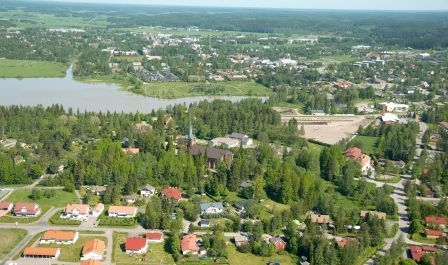
https://www.somero.fi/
二、自然地理
1.地理条件
Somero is the easternmost municipality in the current province of Southwest Finland. The municipality of Somero is bordered on the north by Kanta-Häme and on the east by the province of Uusimaa. Somero's neighboring municipalities in Kanta-Häme are Ypäjä, Jokioinen and Tammela and in Uusimaa Lohja (formerly Nummi and Pusula, later Nummi-Pusula). Neighboring municipalities in Southwest Finland are Salo in the south (formerly Kiikala and Kuusjoki), Koski Tl in the west and Loimaa in the northwest (formerly Mellilä and the municipality of Loimaa). The nearest city centers are in Fors in the north, Salo in the south, Loimaa in the northwest, Lohja in the southeast and Karkkila in the east. Of the large cities, Somero is particularly affected by Turku and Helsinki, and to a lesser extent Hämeenlinna and Tampere.
Somero geographical extreme points of the west and north Eksyssuon Pirttiniemennokka Viluksela, East Heinjärv Somerniemi Härjänojalla and south Lammi Source Somerniemi Kaskistossa. The highest point of Somero is Murjumäki in the village of Mäyrämäki in Somerniemi, which rises to a height of 159.1 meters
In the Finnish landscape division, Somero mainly belongs to the Southwest and to the Southwest farming region. Somerniemi also includes the Kisko - Vihti lake region, which belongs to the southern coastal land, and the Tammela plateau region, which belongs to the Häme farmland and lake land.
In the south - western arable land, the most common type of soil is clay, which occurs in large plains erupted by moraine and rock bumps. In these, rivers have in some places eaten deep valleys, which tend to follow bedrock fractures. There are few lakes. The most well-known river valley formations in this area are the Häntälä notches in southwestern Somero, which form a valuable traditional biotope area.
As the Tammela plateau approaches, the rock and moraine elevations increase and the relative elevation differences increase to decrease again in the highlands themselves in the northeastern parts of Somerniemi. There are more lakes.
When entering the Kiskon - Vihti lake district, the Third Salpausselkä also passes through Somero in Somerniemi. It expands between Painio and Oinasjärvi and on the border of Kiikala east of Lake Halkjärvi into extensive edge formations, which also include longitudinal ridges. There are also many small lakes here. There are also smaller ridge formations in the western parts of Somero, especially along the Paimionjoki river.
2.交通情况
Somero's main traffic routes include main road 52, which brings traffic from Salo and, after construction of Highway 1 as a motorway, also from Turku. From Somero, the road leads to Highway 10 in Jokioinen and also provides connections in the direction of Loimaa. Address names are on the road driving south of Somero center Helsingintie and Salontie and center driving north Jokioistentie. Another significant traffic corridor in Somero is the regional road 280, which originates from Seututie 110 in Nummi-Pusula, joins the main station of Somero 52 and brings traffic from the direction of Helsinki. From the nearby towns in the direction of Forssa, traffic is brought by the regional road 282, which diverges from the main road 52 in Somero's Pikku-Joensuu and joins the highway 2 in Forssa's Kassinmäki, whose address is Somero's Laitiaistentie. In addition, in the Somero area, highway 10 in Somero Viluksela and highway 2 in Somerniemi Salkola run a short distance within the city limits.
三、经济发展和规模
The operating expenses of the initial budget for 2019 was EUR 71.73 million. During the year, 1.36 million was approved. After the increases, appropriations totaled EUR 73.1 million. Realized operating expenses in the income statement were EUR 71.42 million. which is below the budget of 1.68 million euros. Operating income was budgeted at EUR 18.86 million. Appropriations were increased EUR 30,000, after which revenue appropriations totaled EUR 18.89 million. Realization of revenue was 19.33 million euros. Revenue exceeded the estimate by EUR 0.44 million euros.
Operating margin (difference between operating income and expenses) was EUR 52.09 million. It amounted to approx. EUR 2.1 million better than budgeted. This is due to the fact that operating costs were lower and sample yields were somewhat exceeded. In the initial budget, the operating margin was estimated at EUR 54.2 million after additional appropriations. but the final realization was EUR 52.09 million.
Tax revenue was budgeted at EUR 28.2 million. The realization was EUR 27.5 million. Consequently, tax revenue was less than the estimated approximation. EUR 25.2 million had been set aside for state contributions, and their implementation was EUR 25.65 million. EUR 0.47 million was exceeded.
https://www.somero.fi/kaupunki-ja-hallinto/talous-ja-strategia/
四、产业特点/重点项目
Somero's economy is still strongly agricultural. In Somero, primary production employs 15%, services 55% and processing 30% of the working population. According to Practical Maamies, in 2011, according to Finnish arable hectares, 20 of the 1000 largest farms operated in Somero.
Investments:
EUR 4.43 million had been set aside in the budget for investments. Additional appropriations of approx. 0.27 million were approved. after which the appropriations were EUR 4.7 million. euros. Actual expenses were MEUR 2.87. EUR, ie about 1.84 million less than estimated. Approximately EUR 0.4 million in financial contributions were recorded. (multipurpose hall and public fixed assets / municipal construction). Revenue from the disposal of fixed assets was provided for in the budget after funds totaling EUR 7.2 million. Of this, approx. 0.15 million was realized. EUR 1.86 million had been set aside for building construction investments. Actual expenditure totaled 1.1 mln. euros. The largest investment was the renovation of the multipurpose hall. EUR 0.73 million had been set aside for this. EUR 2.1 million had been set aside for the construction of public fixed assets. Actual expenses were 1.35 mln. euros.
五、风景名胜,景点( attractions)
1. Somero Church
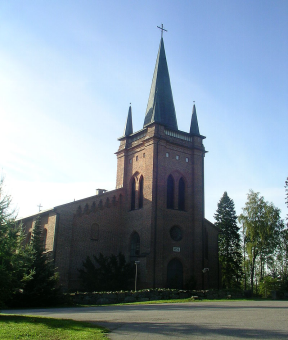
Somero Church Somero Kirkonmäki in Somero has a long neo-Gothic red brick church designed by Georg Theodor Chiewitz. The church was completed in 1859. The church has 1,500 seats.
The church organ was manufactured by JA Zachariassen's organ construction in 1880. Changes were made to the organ in the 1960s and 1970s, but they were restored in 2000. The instrument is a valuable example of Finnish organ building history.
In the National Board of Antiquities' list of nationally significant cultural environments published in 2009, the Somero church environment, which also includes the medieval Somero stone archipelago, is defined as a nationally significant built environment.
https://fi.wikipedia.org/wiki/Someron_kirkko
2. Castle Hiidenlinna and adventure park Sisumetsä
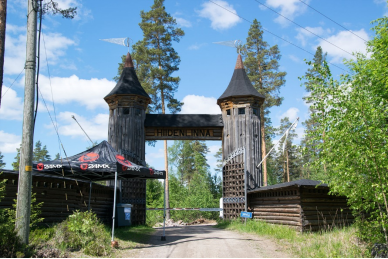
Hiidenlinna is a totally unique medieval style stone castle designed and built by a local artist Reino Koivuniemi. The building was completed in the 1990s and the ground around it holds many handmade art pieces and curious details. The castle is owned by a former downhill skier Sami Uotila
Around the unique area is also freshly built adventure park Sisumetsä where you can challenge yourself and your friends on various levels of adventure tracks that include cable sliding, climbing and even Tarzan leap! Safety harness guarantee 100 % safety even though adventures happen high on trees. You can find open terrace built 5 meters above ground level and suspension bridges connected to lookouts. Totally unique suspension bridges are on just their own exciting adventure for seniors and those who aren’t excited about balancing on cables. Also Hiidenlinna holds Ski Museum, Hiidenpolku for children and tavern style café with outside terrace. You can also pick souveniers from gift shop and admire the changing art exhibitions.
https://www.hiidenlinna.com/
3. Saunahouse Pellavankukka
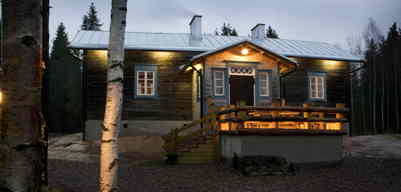
Somero, but the log building has a long, and slightly different tradition elsewhere.
The charming sauna room was once the main building of the Iso-Vaitti farm in Pirkkala, in the village of Partola. From there, it was moved from the feet of a new golf course in 2003 to Somero to the lands of Village Timper.
When the frame was dismantled, workers' magazines from 1905 were found in the house's chimney, which refers to the year the house was built. The logs in a house over a hundred years old, though, may be even older.
After the move, the building was carefully restored using traditional building materials and respecting the best features of the old log building.
The village of Kylä-Timper, where Pellavankukka Saunatupa now operates, is a farm grown by the same family in Somero for the fifth generation. Flax has been grown on the farm for ten years and reed canary grass since then. In the name of the sauna hut, however, linen will continue to be a part of the life of the farm.
http://www.pellavankukka.fi/
六、历史文化
1.历史
Somero is located on the border of the historical provinces of Häme and Southwest Finland. In the east, Somero is also bordered by the historic province of Uusimaa and in the west by Satakunta. The border between Turku and Hämeenlinna castle counties ran through Somero south of the Paimionjoki watershed so that the southernmost parts of present-day Somero were Turku and the larger northern part of Hämeenlinna castle counties, and according to the latest study, this has also been an old inter-provincial enjoyment border. Lakes sediments pollen studies based on the cultivation of based settlement has been concluded to have begun in Somero in the 14th century.
Somero was first mentioned as a chapel or an independent parish in 1449 and was probably an independent parish in 1492 at the beginning. Initially, the parish included only the northern part of the present-day Häme castle district of Somero, but in 1492 the seven villages of the former South Somero were added to the parish. By the end of the 14th century, Somero must have been at least a chapel parish, which was probably read with Tammela, for example, to the parish priest of Hattula when the present South Somero belonged to Uskela.
In the local government of Kruunu, the northern parts of Somero belonged to the administrative administrator of Loimo, or Porta, from Häme, forming the quarters of Pitkäjärvi and Hirsjärvi within it. The stair administrator ceased to exist at the latest in the 18th century, when Tammela and Somero became their own namesake. At the same time, the villages in the southern part of Somero belonged to the actual administrator of Muurla County (later Kisko or Kiikala).
From the provinces of Finland, the northern part of Somero belonged to the counties of Häme and Uusimaa from 1635, then from 1830 to the counties of Häme and from 1635 to the counties of Turku and Pori. In the 1870s, the boundaries of the counties were adjusted to the boundaries of the parishes, and southern Somero also became part of Häme County.
By 1695, the Somerniemi Chapel Parish was formed inside the Somero parish. Under the Municipal Decree of 1865, it and the Somero Parish became their own municipalities. In 1901, Somerniemi became an independent parish.
When the rural population decreased throughout Finland from the 1960s onwards, this in many places led small municipalities to municipal associations. As part of this development, the municipality of Somerniemi was annexed to Somero in 1977.
For almost the entire 20th century, Somero was part of Häme County and the southern constituency of Häme County. Within Häme County, Somero was initially under the influence of Hämeenlinna at the provincial level and Forssa at the regional level as part of the southwestern part of the province of Häme around Forssa. However, the most significant centers in Hämeenlinna in Somero were Turku and Helsinki in the 20th century, and Salo, which was the closest regional center on the Southwest Finland side, competed equally strongly with Forssa. In this situation, Somero's relations with Southwest Finland and at the same time with the Salo region gradually intensified.
In 1990, Somero became part of the Turku and Pori counties and the southern constituency of Turku and Pori counties. Even before that, Somero and Somerniemi belonged to the Salo Regional Planning Association from the 1960s onwards, and then to the Southwest Finland Regional Planning Association, which succeeded him in the 1970s. When the regional planning associations and regional associations were merged in the early 1990s, Somero continued as part of the Southwest Finland Regional Planning Association and the Southwest Finland Regional Association, and thus became part of the current province of Southwest Finland and within it the Salo region.
Somero became a city in 1993. In the county reform of 1997, Somero became part of the province of Western Finland, which ceased to exist at the beginning of 2010 in the state administration reform.
2. 文化体育
Somero dialect belongs to a separate group southwestern dialects and Häme dialect between lunches välimurteisiin. Somero has a hometown association, the Somero Society. Its achievements include the Somero Croft Museum, the Kultela Pottery Museum and the Pajula School Museum. Both dialect and proverb books have also been published by Somero. Somerniemi also has its own homeland association, the Somerniemi Society, which e.g. maintains the Somerniemi summer market and also engages in publishing activities.
Of the cultural environments built by Somero, the Häme bull road, the church environment of Somero, the Palikainen manor landscape and the location of Åvik Manor and the glass factory have been assessed as nationally significant.
七、其他信息
Hämeen Härkätie is a historical road and tourist road that runs from Turku to Hämeenlinna. According to the theory presented by the historian Jaakko Masonen, Härkätie was born in the 8th century at the latest, when furs and a medicine-used stew were brought to the marketplaces of Western Finland. Häme, on the other hand, has taken weapons, jewelery, metal and salt from the coast. Hämeen Härkätie was an important traffic route, as there was no other route from the coast to Häme, because the rivers were low-water and rapids. Still, the road is not prehistoricat the end of the period, it was likely to be like a narrow path cleared of vegetation that crossed waterways and wetlands with the help of elongated trees and rock atoms. There is definite evidence of the existence of the Bull Road since the Middle Ages, when it connected the castles of Turku and Häme.
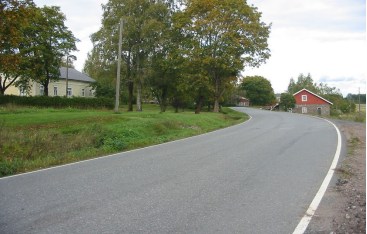
八、联系方式
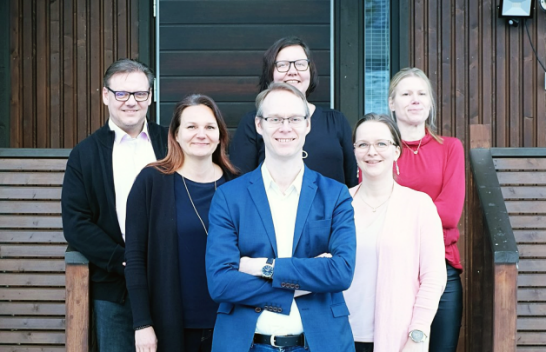
Mayor: Sami Suikkanen (center image)
Telephone: (02) 7791 1
Email: info@somero.fi
https://www.somero.fi/
